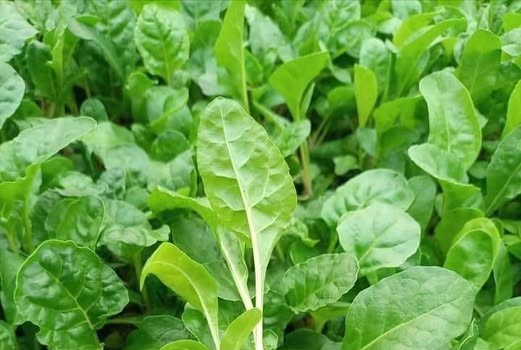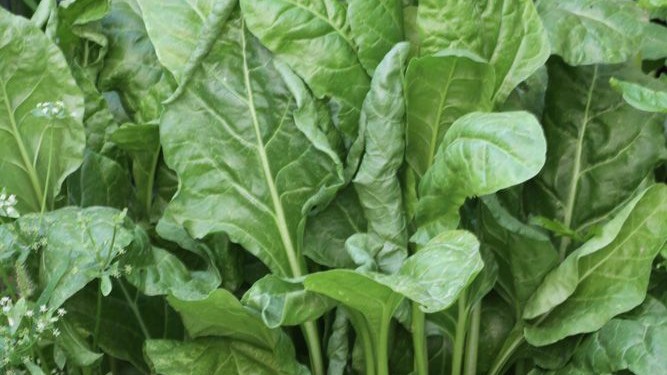Spinach is a highly nutritious leafy green that grows quickly and thrives in cooler weather. It’s perfect for both small gardens and larger commercial farms. Whether you’re growing spinach for personal use or for the market, this stepbystep guide will help you navigate the process from seed selection to harvest.

Site Selection and Soil Preparation
Climate Needs
Spinach grows best in cooler temperatures, ideally between 50°F to 60°F (10°C to 16°C). It thrives in full sunlight but can tolerate partial shade, especially in warmer climates. Spinach is frost-tolerant and can withstand light frosts, making it suitable for spring or fall planting.
Soil Requirements
Spinach prefers well-draining, loamy soil rich in organic matter. The soil pH should ideally range from 6.0 to 7.5. To improve soil quality, mix in organic compost or well-rotted manure. If the soil is heavy clay or overly sandy, amend it with compost to improve texture and water retention.
Soil Testing
Before planting, conduct a soil test to determine nutrient levels. Based on the results, you may need to apply fertilizers, especially those rich in nitrogen, phosphorus, and potassium.
Land Preparation
Clearing the Field
Begin by clearing the land of any weeds, rocks, or debris to prevent competition for nutrients and water.
Tilling
Till the soil to a depth of 6–8 inches (15–20 cm). This loosens the soil, improves aeration, and allows roots to penetrate more easily. For large-scale farms, use a tractor, while for smaller gardens, a hand hoe can work effectively.
Amend the Soil
Incorporate well-rotted compost or organic manure into the soil to improve fertility and moisture retention. This is especially important if the soil lacks essential nutrients.
Seed Selection and Sowing
Choosing the Right Variety
Select a spinach variety suited to your growing conditions. Common options include:
- Savoy spinach: Has crinkled leaves and is ideal for cooler climates.
- Flatleaf spinach: Features smooth leaves and is often used for processing.
- Semisavoy spinach: A hybrid between the other two types.
Seed Rate and Spacing
For good yields, plant about 4–6 kg of seeds per acre. Sow seeds 1–2 inches apart (2.5–5 cm) in rows spaced about 12–18 inches apart (30–45 cm). Plant seeds at a depth of ½ inch (1.5 cm). Spinach can be sown directly in the field after the last frost date in spring or about 6–8 weeks before the first frost in fall.
Watering
Consistent Moisture
It needs consistent moisture, especially during the germination phase. Aim to keep the soil evenly moist but avoid overwatering, as spinach is prone to root rot if the soil is waterlogged. Drip irrigation or a gentle overhead sprinkler is ideal for maintaining moisture without soaking the plants.
Watering Frequency
Water regularly, providing 1–1.5 inches of water per week, depending on rainfall. As the plants mature, reduce watering slightly to avoid excessive moisture around the roots.
Fertilization
Nutrient Requirements
It is a heavy feeder and benefits from frequent feeding, particularly nitrogen, to promote lush leaf growth. Apply a balanced fertilizer (like 10-10-10) at planting, followed by nitrogen-based fertilizers about 2–3 weeks after sowing.
Organic Fertilizers
If you prefer organic farming, use well-rotted manure or compost to feed the plants. Organic liquid fertilizers can also be effective.
Pest and Disease Management
Common Pests
- Aphids: Tiny insects that suck sap from the leaves.
- Leaf miners: Larvae that tunnel into the leaves.
- Slugs and snails: These pests chew holes in spinach leaves.
Use organic insecticides like neem oil or introduce natural predators, such as ladybugs, to manage pest populations.
Common Diseases
- Downy mildew: Causes yellowing leaves and thrives in damp conditions. Avoid overhead watering and improve airflow around plants.
- Powdery mildew: A fungal disease that affects older leaves. Remove infected leaves and apply fungicides if needed.
Crop rotation can also help prevent the buildup of soilborne diseases.
Thinning and Weeding
Thinning
Once seedlings are established, thin them to about 4–6 inches (10–15 cm) apart. This reduces competition for nutrients and provides the plants with enough space to grow.
Weeding
Weed regularly, especially during the early growth stages, to prevent competition for water and nutrients. Mulching can also help suppress weed growth and retain soil moisture.
Harvesting
Harvesting Time
It is usually ready for harvest 30–45 days after sowing. Harvest young leaves as needed or wait until the plant is fully mature. To ensure continuous harvests, use the cut-and-come-again method, where you cut the outer leaves and leave the center intact.
For a one-time harvest, pull the entire plant once it reaches maturity.
Post-Harvest Handling
Handle spinach carefully to avoid bruising. Rinse the leaves thoroughly to remove dirt or pesticides and store them in a cool place. Fresh spinach can be refrigerated for 5–7 days.
Post-Harvest Management
Storage
To extend freshness, store spinach in perforated plastic bags in the refrigerator. If you have excess spinach, consider blanching and freezing it for long-term storage.
Yield Expectations
A well-managed spinach crop can yield around 5–10 tons per acre, depending on factors like variety, soil fertility, and climate conditions. Consistent care throughout the growing season, including proper watering, fertilization, and pest control, will lead to a higher-quality harvest.
Spinach Farming: Benefits and Tips for Successful Cultivation
Spinach farming is a highly rewarding agricultural practice due to its numerous health benefits and quick-growing nature. Whether you’re a commercial grower or a home gardener, spinach cultivation offers a variety of advantages:
1. Rich Nutritional Value
It is a powerhouse of essential nutrients, including vitamins A, C, and K, folate, iron, and calcium. It’s an excellent addition to any diet, promoting overall health and well-being. Spinach farming provides a steady supply of these nutrients, supporting immune function, bone health, and improving skin quality.
2. Supports Digestive Health
The high fiber content in spinach makes it a great aid in digestion. Farming spinach enables consumers to incorporate this nutritious green into their daily meals, helping to regulate bowel movements and prevent constipation.
3. Boosts Iron Levels
It is known for its iron content, essential for the production of hemoglobin in the blood. Growing spinach is beneficial for addressing iron deficiencies, especially in those who prefer plant-based diets. This can help in the prevention of anemia and improve overall energy levels.
4. Easy to Grow with Minimal Space
It is a versatile crop that thrives in both small-scale and large-scale farming setups. It requires minimal space and can be grown in raised beds, greenhouses, or traditional soil. Its short growing season—typically 6 to 8 weeks—ensures quick returns on investment.

5. Low Maintenance Crop
Spinach farming is relatively low-maintenance. With proper care, including adequate watering, pest management, and soil preparation, spinach plants are robust and resistant to many common plant diseases. This makes spinach an ideal crop for both novice and experienced farmers.
6. Environmental Sustainability
It is a cool-season crop that requires less water compared to many other vegetables, making it an environmentally friendly farming option. Additionally, spinach’s rapid growth allows for multiple harvests in a year, optimizing land use and contributing to sustainable farming practices.
7. Rich in Antioxidants
It contains antioxidants like lutein and beta-carotene, which help protect the body from free radical damage. Including spinach in a healthy diet may help reduce the risk of chronic diseases such as cancer, cardiovascular issues, and eye degeneration.
8. Enhances Skin Health
With its high vitamin C content, spinach helps stimulate collagen production, promoting healthy and youthful skin. Spinach farming offers a sustainable way to access this natural skincare solution directly from the source.
Tips for Successful Spinach Farming:
- Soil Requirements: It grows best in well-drained, nutrient-rich soil with a pH level between 6.5 and 7.5.
- Climate Preferences: This leafy green thrives in cooler temperatures, making it ideal for spring and fall planting.
- Watering Needs: Regular watering is essential, but be cautious of waterlogging. Consistent moisture helps the plant grow strong.
- Pest Control: While it is generally resilient, watch out for aphids and slugs, which may affect its growth. Using organic pest control methods is recommended.
Conclusion
With the right site, soil, and care, spinach farming can be a highly rewarding venture. Whether you’re growing in a small garden or on a larger scale, following these steps will help you achieve a healthy, productive crop. By monitoring soil health, managing pests, and harvesting at the right time, you’ll enjoy a steady supply of this nutritious green, whether for your own consumption or for sale at local markets.